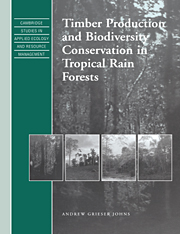Book contents
- Frontmatter
- Contents
- Foreword
- Preface
- Explanatory note
- 1 The issues
- 2 The history and development of tropical forestry
- 3 Changes in the physical environment
- 4 Forest regeneration and gap dynamics
- 5 Responses of individual animal species
- 6 Responses of species assemblages
- 7 Using ecological data in forest management planning
- 8 Intervention to maintain biodiversity
- 9 Field procedures
- 10 The future
- References
- Subject index
5 - Responses of individual animal species
Published online by Cambridge University Press: 04 December 2009
- Frontmatter
- Contents
- Foreword
- Preface
- Explanatory note
- 1 The issues
- 2 The history and development of tropical forestry
- 3 Changes in the physical environment
- 4 Forest regeneration and gap dynamics
- 5 Responses of individual animal species
- 6 Responses of species assemblages
- 7 Using ecological data in forest management planning
- 8 Intervention to maintain biodiversity
- 9 Field procedures
- 10 The future
- References
- Subject index
Summary
Introduction
Animal communities in tropical forests live within a mosaic of subhabitats caused by different local edaphic conditions and different stages of the lifecycle of treefall gaps. Each patch in the mosaic may be occupied by a different array of plants and animals, some resident and some transient. The degree of transience in animals can be very high (Karr & Freemark 1983). The extent of specialization to particular subhabitats also varies considerably, being most evident among small folivores (such as insect larvae which may live only on certain parts of certain plant species) and least evident among large-bodied frugivore-folivores.
Food resources for frugivores tend to be widely dispersed in the forest, those for folivores less so. Both may be affected by changing patterns of food tree distribution following logging. Many climax food trees are randomly distributed in primary forest, but become patchy following intensive logging operations. In a peninsular Malaysian dipterocarp forest, for example, four important taxa of food trees became localized to the less damaged valleys following a combination of conventional and high-lead logging(1:51) that severely damaged forest along ridgetops (Johns 1988). Such differences may necessitate changes in foraging behaviour among associated animal species. Changes will be most pronounced where the animals are specialists of the trees concerned.
Food resources for insectivores are stable and predictable in unlogged forest but become less so following logging. This reflects changes in the seasonality of primary production. Food resources available to predators and to decomposers may also vary considerably between unlogged and logged forests.
- Type
- Chapter
- Information
- Publisher: Cambridge University PressPrint publication year: 1997



